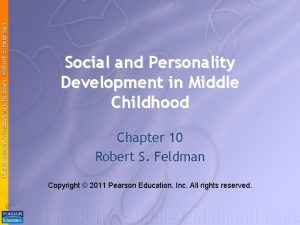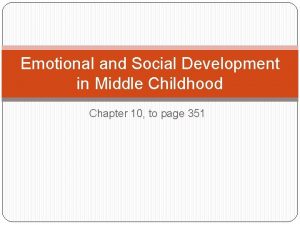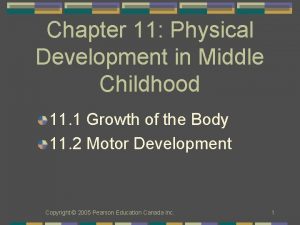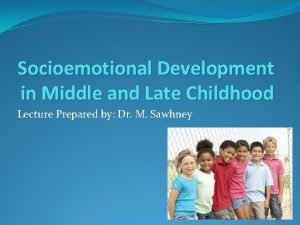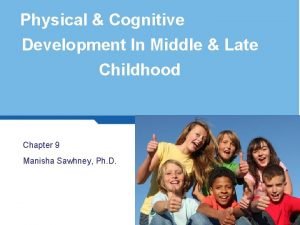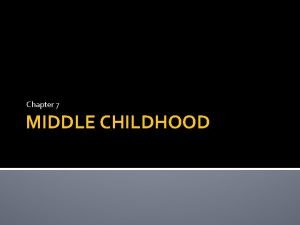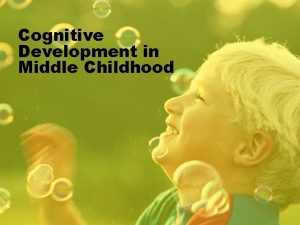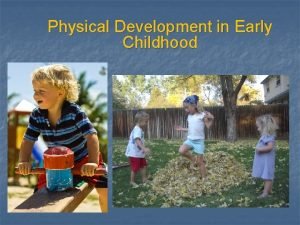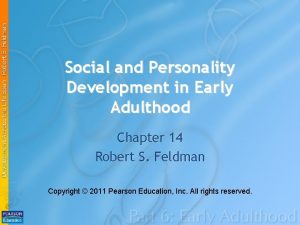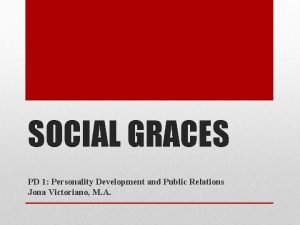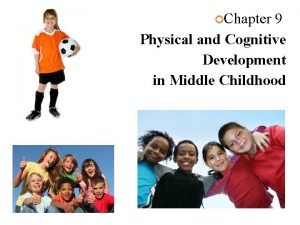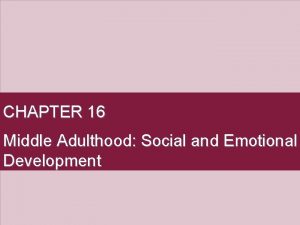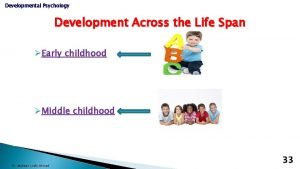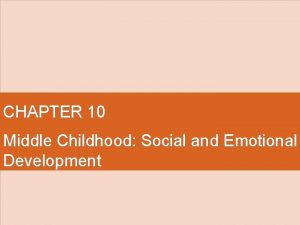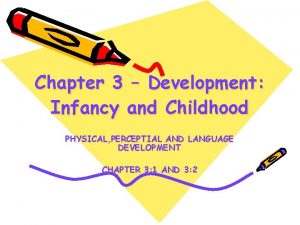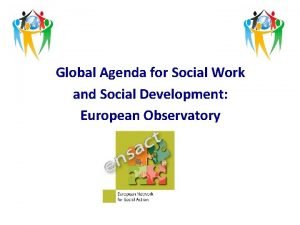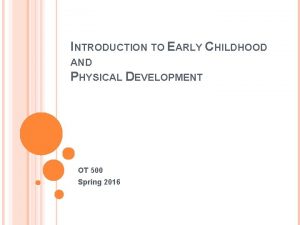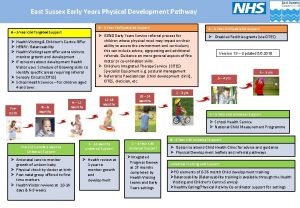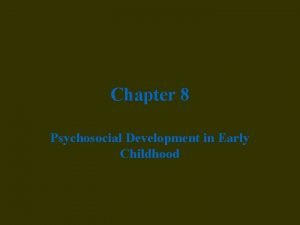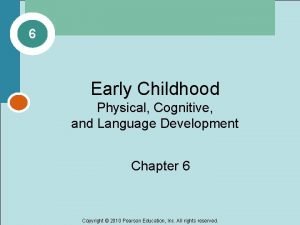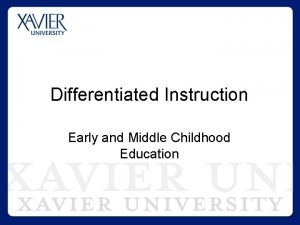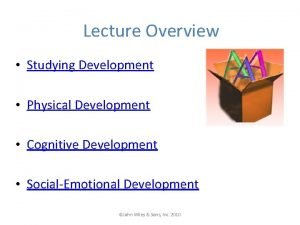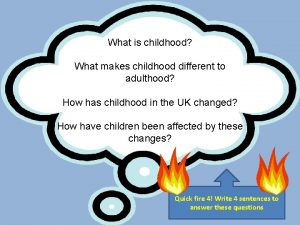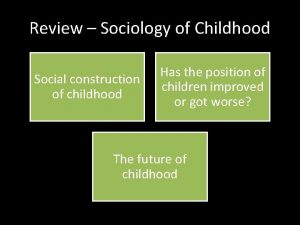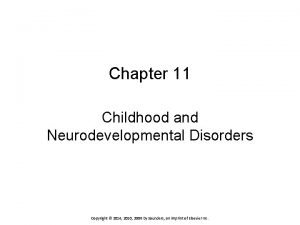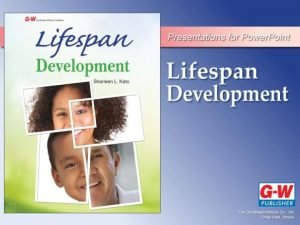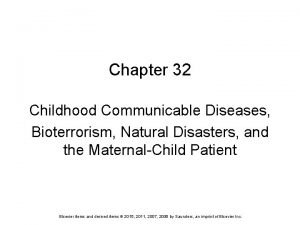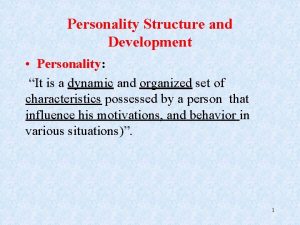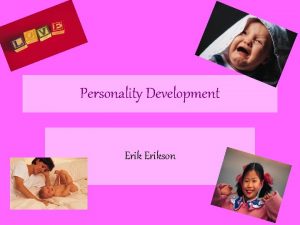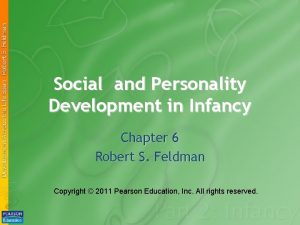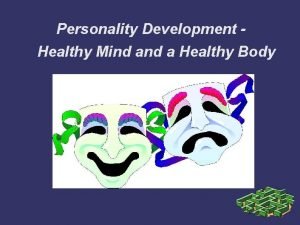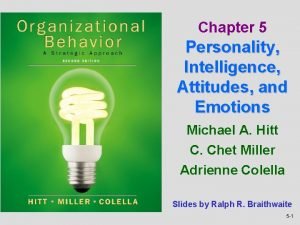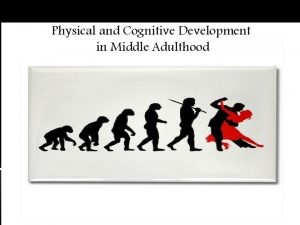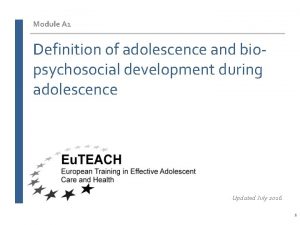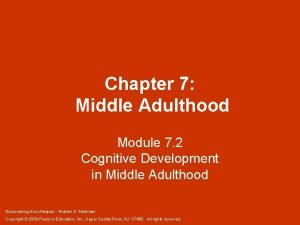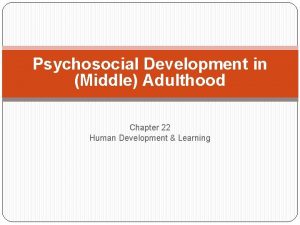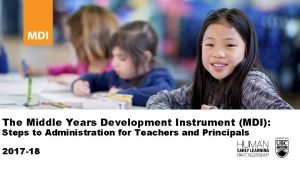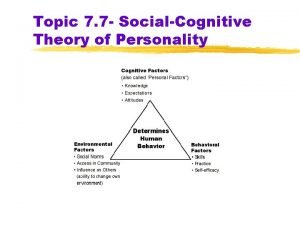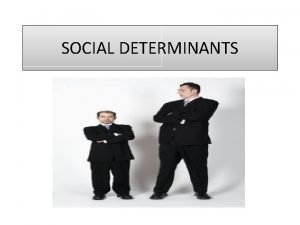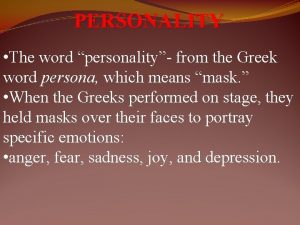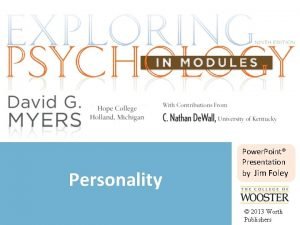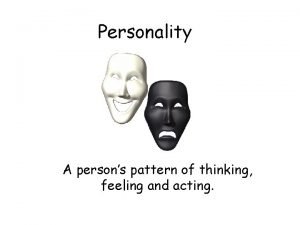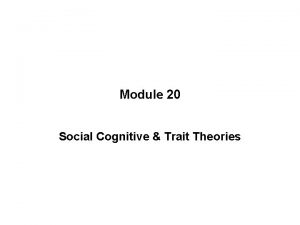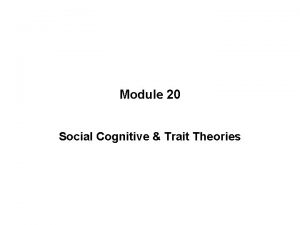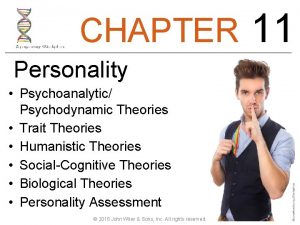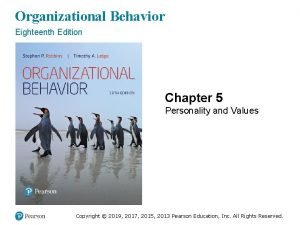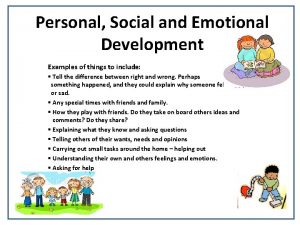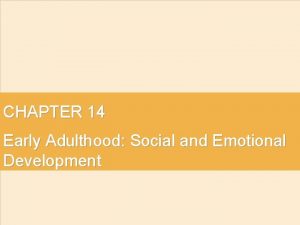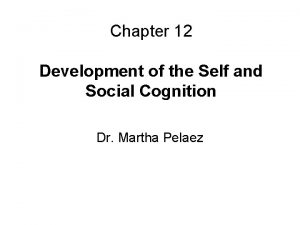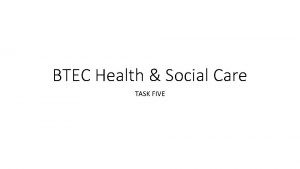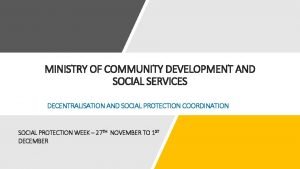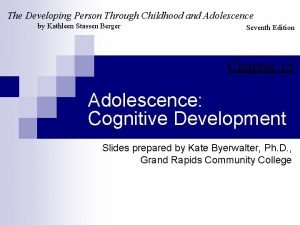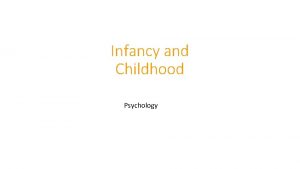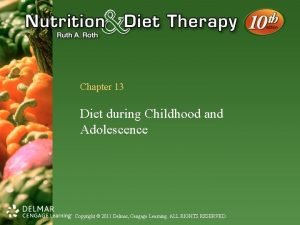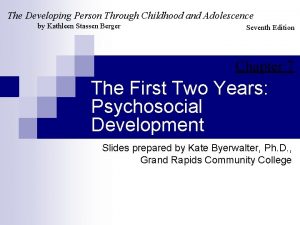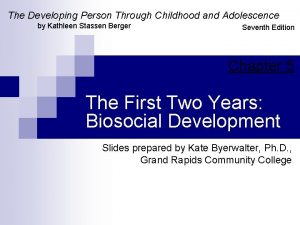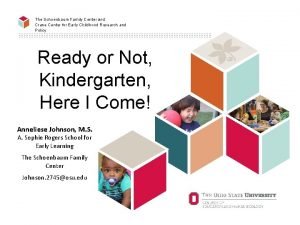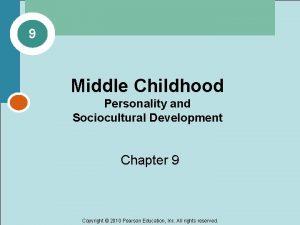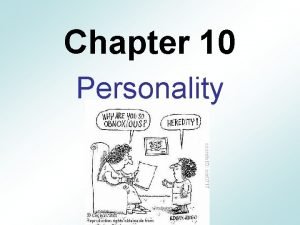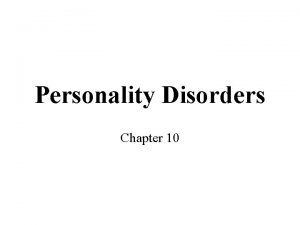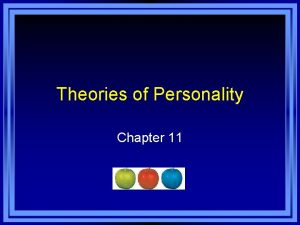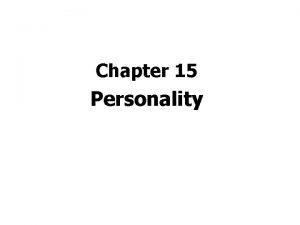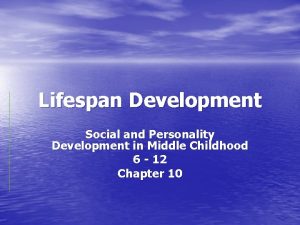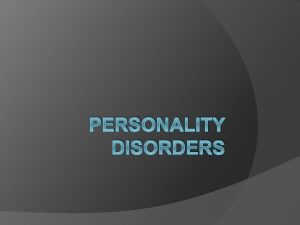Social and Personality Development in Middle Childhood Chapter




































































































- Slides: 100

Social and Personality Development in Middle Childhood Chapter 10 Robert S. Feldman Copyright © 2011 Pearson Education, Inc. All rights reserved.

Looking Ahead In what ways do children’s views of themselves change during middle childhood? Why is self-esteem important during these years? How does children’s sense of right and wrong change as children age? What sorts of relationships and friendships are typical of middle childhood?

Looking Ahead How do gender and ethnicity affect friendships? How do today’s diverse family and care arrangements affect children? How do children’s social and emotional lives affect their school performance?

THE DEVELOPING SELF

Who Am I? During middle childhood, children begin to view themselves: Less in terms of external physical attributes More in terms of psychological traits

Psychosocial Development in Middle Childhood Industry Versus Inferiority Industry = feelings of mastery and proficiency and a growing sense of competence Inferiority = feelings of failure and inadequacy

Erikson’s middle childhood Encompasses the INDUSTRYVERSUS INFERIORITY STAGE Period from ages 6 to 12 years of age Characterized by a focus on efforts to attain competence in meeting the challenges related to: Parents Peers School Other complexities of the modern world

How do school-agers change? Children realize they are good at some things and not so good at others Self-concept and self-esteem continue to develop

A Closer Look

Children look to others who are similar to themselves

Compared to… Children use SOCIAL COMPARISON to themselves to abilities, expertise, and opinions of others

Festinger (1959) proposed When objective measures are absent children rely on social reality How others act, think, feel, and view the world

Sometimes… children make downward social comparisons With others who are: Less competent Less successful To raise or protect their self-esteem

SELF-ESTEEM Develops in important ways during middle childhood Children increasingly compare themselves to others Children are developing their own standards For most children self-esteem improves in middle childhood

Viewing the Cycle of Failure

Breaking the Cycle of Failure Promoting development of self-esteem Using authoritative child-rearing style Why do you think this style is recommended?

Race and Self-Esteem Early research found that African Americans had lower self-esteem than whites More recent research shows these early assumptions to be overstated African Americans Hispanic Americans Asian Americans

Why does this occur? Social Identity Theory Members of a minority group accept negative views held by majority group only if they perceive little realistic possibility of changing power and status differences between groups

Developmental Diversity Are Children of Immigrant Families Well Adjusted? Tend to have equal or better grades than children with US born parents Often more highly motivated to succeed and place greater value on education than do children in nonimmigrant families Show similar levels of self-esteem to nonimmigrant children Report feeling less popular and less in control of their lives

Moral Development: Kohlberg • Proposes series of fixed stages in development of moral reasoning • Uses moral dilemmas to assess moral reasoning • Provides good account of moral judgment but not adequate at predicting moral behavior

Kohlberg Stages Preconventional Morality (stages 1 & 2): people follow unvarying rules based on rewards and punishments Conventional Morality (stages 3 & 4) is where people approach problems in terms of their own position as good, responsible members of society Postconventional Morality (stages 5 & 6) is where universal moral principles are invoked and considered broader than a particular society

Kohlberg Criticisms Based solely on observations of members of Western cultures Theory initially based largely on data from males

MORAL DEVELOPMENT IN GIRLS

Carol Gilligan Way boys and girls raised leads to differences in moral reasoning Suggests Kohlberg’s theory inadequate and places girls’ moral reasoning at lower level than boys’

Gilligan’s Stages of Morality in Girls

Review and Apply REVIEW According to Erikson, children at this time are in the ____-versus-inferiority stage. In the middle childhood years, children begin to use ____and self-concepts based on ____ rather than physical characteristics. During the middle childhood years, self-esteem is based on ____ with others and internal standards of ____; if self-esteem is ____, the result can be a cycle of failure.

Review and Apply REVIEW According to Kohlberg, ____ development proceeds from a concern with ____ and ____, through a focus on social conventions and rules, toward a sense of universal ____ principles. Gilligan has suggested, however, that ____ may follow a somewhat different progression of ____ development.

Review and Apply APPLY Kohlberg and Gilligan each suggest there are three major levels of moral development. Are any of their levels comparable? In which level of either theory do you think that the largest discrepancy between males and females would be observed? What can teachers do to help children whose low selfesteem is causing them to fail? How can this cycle of failure be broken?

RELATIONSHIPS: BUILDING FRIENDSHIP IN MIDDLE CHILDHOOD

Friends in Middle Childhood • Provide emotional support and help kids to handle stress • Teach children how to manage and control their emotions • Teach about communication with others • Foster intellectual growth • Allow children to practice relationship skills

Damon’s Stages of Friendship Stage 1 (ages 4 -7 years) Children see friends as like themselves Children see friends as people to share toys and activities with Children do not take into account personal traits

Damon’s Stages of Friendship Stage 2 (ages 8 -10 years) Children now begin to take other’s personal qualities and traits into consideration Friends are viewed in terms of kinds of rewards they provide Friendships are based on mutual trust

Damon’s Stages of Friendship Stage 3 (ages 11 -15 years) Friendships become based on intimacy and loyalty Friendships involve mutual disclosure and exclusivity

Who was your best friend during middle childhood?

Likes me…likes me not!

INDIVIDUAL DIFFERENCES IN CHILDREN’S FRIENDSHIP

King or Queen of the Hill…Status Hierarchies Children’s friendships show clear hierarchies in terms of STATUS is the evaluation of a role or person by other relevant members of a group

High Status Children Form friendships with high status children More likely to form exclusive and desirable cliques Tend to play with a greater number of children Have greater access to resources such as games, toys, books, and information

Low Status Children Form friendships with other lower status children Tend to play with a lower number of children than higher status children Are more likely to play with younger or less popular children Tend to follow the lead of higher status children

What Personal Characteristics Lead to Popularity?

Popular Children Helpful and cooperative Good sense of humor Good emotional understanding Ask for help when necessary Not overly reliant on others Adaptive to social situations Social problem-solving skill competence

Social Problem-Solving and Information Processing

Unpopular Children Lack social competence Immature or inappropriately silly Overly aggressive and overbearing Withdrawn or shy Unattractive, handicapped, obese, or slow academically

Unpopular Children Lack of popularity may take two forms: NEGLECTED CHILDREN receive relatively little attention from their peers in the form of either positive or negative interaction REJECTED CHILDREN are actively disliked and their peers may react to them in an obviously negative manner

Teaching Social Competence Several programs teach children set of social skills that underlie general social competence Before we review these, take a few minutes to visit with a classmate about what kind of program would best enhance social competence. Report to the class.

Bullying SCHOOL- THE BULLY 160, 000 U. S. schoolchildren stay home from school each day because they are afraid of being bullied About 10 to 15 percent of students bully others at one time or another. About half of all bullies come from abusive homes.

Bully SCHOOL – BULLIED Some 90 percent of middle-school students report being bullied at some point in their time at school, beginning as early as the preschool years Characteristics Loners who are fairly passive Often cry easily Lack the social skills that might otherwise defuse a bullying situation

When the Pink Princess Becomes a Bully! Resources about Relational Aggression Among Girls Odd Girl Speaks Out: Girls Write about Bullies, Cliques, Popularity, and Jealousy Rachel Simmons Mean Chicks, Cliques, and Dirty Tricks: A Real Girl's Guide to Getting Through the Day With Smarts and Style Erika V Shearin Karres Girl. Wise: How to Be Confident, Capable, Cool, and in Control Julia Devillers The Bully, the Bullied, and the Bystander: From Preschool to High School--How Parents and Teachers Can Help Break the Cycle of Violence Barbara Coloroso

Do bystanders contribute to bullying?

Sex Segregation of Middle Childhood

Boyfriend, girlfriend…any friend? Avoidance of opposite sex becomes very pronounced during middle childhood Children’s friendships are almost entirely sex-segregated When sexes interact it is called “border work, ” is often romantic, and helps emphasize clear boundaries between sexes

Boys and Friendship Larger networks of friends than girls do Strict DOMINANCE HIERARCHY Attempt to maintain and improve status in hierarchy Restrictive play

Girls and Friendships • Focus on one or two “best friends” of relatively equal status • Conflicts solved by compromise, ignoring situation, or giving in • Can be confrontational with other girls not their friends • Language is less confrontational and direct than boys’

Are friendships color-blind?

Cross-Race Friendships: Integration In and Out of the Classroom Closest friendships largely with others of same race Decline with age in number and depth of friendships outside own racial group

Reducing Prejudice through Contact Between Groups CONTACT Must occur in equal status settings Enhanced through cooperative activities that are important to children Must promote equality and disconfirm negative stereotypes

Becoming an Informed Consumer of Development Increasing Children’s Social Competence Encourage social interaction Teach listening skills to children Make children aware that people display emotions and moods nonverbally Teach conversational skills, including the importance of asking questions and selfdisclosure Don’t ask children to choose teams or groups publicly

Review and Apply REVIEW Children’s understanding of ____ changes from the sharing of ____ activities, through the consideration of ____ traits that can meet their needs, to a focus on ____ and loyalty. Friendships in childhood display ____ hierarchies. Improvements in social ____ and social information processing can lead to better ____ skills and greater popularity. Boys and girls engage increasingly in same-sex friendships, with boys’ friendships involving ____ relationships and girls’ friendships characterized by ____ of girls with equal status.

Review and Apply REVIEW ____ friendships decrease in frequency as children age, but contact as peers among members of different races can promote ____ acceptance and appreciation. Many children are the victims of ____ during their school years, but both victims and bullies can be ____ ways to reduce bullying.

Review and Apply APPLY Do you think the stages of friendship are a childhood phenomenon, or do adults’ friendships display similar stages? How might it be possible to decrease the segregation of friendships along racial lines? What factors would have to change in individuals or in society?

FAMILY AND SCHOOL: SHAPING CHILDREN’S BEHAVIOR IN MIDDLE CHILDHOOD

Middle Childhood in the 21 st Century In addition to other changes, children experience: Increasing independence Co-regulation with parents Sibling relationships and rivalry

From Research to Practice Learning to Get Along: How Children are Influenced by their Siblings Sibling relationships are likely to endure across lifespan Early relationships between siblings shape how children relate to others and choices made in later life

What happens when sibs don’t want to be alike? De-identification Enhances desire to be different from older sibling Influences gender-role behavior improves cross-gender relations later in life

What about children who have no siblings? Only children are as well-adjusted as children with brothers and sisters In some ways, only children are betteradjusted, often having higher self-esteem and stronger motivation to achieve

When Both Parents Work Outside the Home: How Do Children Fare? In most cases, children fare quite well When parents Are loving Are sensitive to their children’s needs Provide appropriate substitute care Good adjustment of children relates to psychological adjustment of parents, especially mothers

What do children do all day? Parents work and children. . . do what

Self-Care Children Youngsters who let themselves into their homes after school and wait alone until their parents return from work

Good or bad? Consequences of being a latchkey child are not all harmful Some children report being lonely Some children develop a sense of independence and competence Some research shows latchkey children have higher self-esteem because they are helping family

The Consequences of Divorce Only half of children in the U. S. will pass through childhood living with both parents each of whom has been married only once School-age children tend to blame themselves for the breakup

After the break… Both children and parents may show several types of psychological maladjustments for 6 months to 2 years Anxiety Depression Sleep disturbances Phobias

Rediscovering the Status Quo After 18 months to 2 years, most children return to their predivorce psychological adjustment Twice as many children of divorced parents require psychological counseling as do children from intact families For some children, living in a home with unhappy marriage and which is high in conflict has stronger negative consequences than divorce

Single Parent Families

Single Parents Almost one-quarter of all children under 18 in the U. S. live with only one parent Numbers are higher for minority children • 60% of African-American children live in single parent homes • 35% of Hispanic children live in single parent homes

Single Parents In majority of cases, single parent is mother Consequences of living in single parent home depend on: • Whether other parent ever lived at home • Economic status

Multigenerational Families Opportunity for rich experiences and conflicts Greater among African Americans than among Caucasians In some families, cultural norms tend to be highly supportive of grandparents taking an active role

Grandparents Raising Grandchildren In 1980, 2. 3 million (4%) children under 18 were living in a grandparent(s)' home Now around 4 million (6%) living with grandparents What are some of the benefits and challenges when grandparents raise grandchildren? Can grandparents raise grandchildren well?

Yours, mine…ours BLENDED FAMILIES include remarried couple that has at least one stepchild living with them Experts predict that by 2000, over 50 percent of children born in the last decade will be stepchildren Living in blended family involves role ambiguity, in which roles and expectations are unclear

Not all the news is bad!! School-age children often adjust relatively smoothly to a blended family • Financial status of family improves • More people to share household chore • More social interaction and attention • But…not all children adjust well, especially if the new relationship is threatening

Families with Gay and Lesbian Parents Between one and five million US families headed by two lesbians or two gay parents Most studies find children: Develop similarly to children of heterosexual families Have sexual orientation unrelated to their parents Have no more or less gender-typed behavior Seem equally well adjusted Have similar relationships with their peers and adults Have romantic relationships and sexual behavior that are no different from those of adolescents living with opposite-sex parents

Race and Family Life What do you know about…? African-American families Hispanic families Asian-American families

Poverty and Family Life Poor families Fewer basic everyday resources More disruptions in children’s lives Higher likelihood of stress

Group Homes… Term “orphanage” replaced by group home or residential treatment center Group homes used for youngsters whose parents are no longer able to care for them adequately

Anybody home? The number of children in group care has growth over 50 percent About three-quarters of children in group homes are victims of abuse and neglect Most will eventually return home, however, onefourth will be in group care throughout childhood

Good or Bad? • Experts disagree on advantages and disadvantages of group care • Some see them as solution to unwed mothers who become dependent on welfare • Many who work in these homes say they cannot provide adequate love and support as family could • Group homes cost ten times as much as foster care or welfare

School: The Academic Environment

School Daze During school year, more of day is spent in a classroom than anywhere else Schools have large influence on children’s lives

How do children explain academic success and failure? Attributions Children attempt to explain their behavior in one of three ways • Whether the cause is internal (dispositional) or external (situational) • Whether the cause is stable or unstable • Whether the cause is controllable or uncontrollable

Attributions matter! Attributions about school successes and failures have important implications for performance If success is internal, children feel pride If failure is internal, children feel shame If success or failure is attributed to stable characteristics, children can expect similar results in future

Lucky ducky! If success or failure is attributed to unstable characteristics (such as luck), their expectations for the future are unknown If children feel failure was within their control, they feel anger If children feel failure was due to uncontrollable reasons, they fell sadness or pity

Attributional Confounds Race, ethnicity, and socioeconomic status have strong influences on attributions of success and failure • African-American children are less likely to attribute success to internal causes, feeling that prejudice and discrimination are to blame • Women tend to attribute failure to low ability and success to luck • In Asian countries, academic success is perceived as being caused by hard work

Developmental Diversity Explaining Asian Academic Success US attribute school performance to stable, internal causes Japan, China, and other East Asian countries see temporary, situational factors as cause of their performance

Teacher Expectancy Effect Cycle of behavior in which teacher transmits an expectation about child and thereby actually brings about expected behavior Self-fulfilling prophecy

From Teacher to Child: How Expectations Are Transmitted Classroom social-emotional climate. Input to children Output from teachers Feedback

Expecting Expectations

Should Schools Teach Emotional Intelligence?

Review and Apply REVIEW Self-care children may develop ____ and enhanced ____ from their experience. How divorce affects children depends on such factors as ____ circumstances and the comparative levels of tension in the family ____ and ____ the divorce. The effects of being raised in a ____ household depend on financial circumstances, the amount of parent–child interaction, and the level of tension in the family.

Review and Apply REVIEW ____ patterns differ along individual, cultural, and gender dimensions. Expectancies, particularly those of ____ and ____ can affect behavior and produce ____ that reflect and confirm the expectancies. ____, the skills that underlie the accurate assessment, evaluation, expression, and regulation of emotions, is becoming accepted as an important aspect of ____.

Review and Apply APPLY Politicians often speak of “family values. ” How does this term relate to the diverse family situations covered in this chapter, including divorced parents, single parents, blended families, working parents, self-care children, abusive families, and group care? How might the development of self-esteem in middle childhood be affected by a divorce? Can constant hostility and tension between parents lead to a child’s health problems?

EPILOGUE Return to the prologue—about Henry’s social struggles —and answer the following questions: How might changes in Henry’s social life shape his self-esteem? Based on Henry’s story, at what stage might William Damon place Henry and his peers’ value of friendship? What characteristics does Henry possess that might suggest that he will be popular among his peers in the longer term? Discuss how the division between the boys and girls at Henry’s school is consistent with psychologists’ ideas of sex integration in middle childhood.
 Damon's stages of friendship
Damon's stages of friendship Social development in middle childhood
Social development in middle childhood Middle childhood and adolescence
Middle childhood and adolescence Physical development in middle childhood chapter 11
Physical development in middle childhood chapter 11 Cognitive development in middle and late childhood
Cognitive development in middle and late childhood Late childhood emotional development
Late childhood emotional development Middle childhood growth and development
Middle childhood growth and development Middle and late childhood
Middle and late childhood Physical development in middle childhood
Physical development in middle childhood Cognitive development in middle childhood
Cognitive development in middle childhood Kellogg drawing stages
Kellogg drawing stages Social development in infancy and childhood
Social development in infancy and childhood Late childhood
Late childhood Late childhood
Late childhood Social and personality development in early adulthood
Social and personality development in early adulthood Define social graces
Define social graces Middle adulthood emotional development
Middle adulthood emotional development Middle and late childhood
Middle and late childhood Early childhood is __________ for language learning
Early childhood is __________ for language learning Middle adulthood social changes
Middle adulthood social changes Childhood personality
Childhood personality Developmental psychology meaning
Developmental psychology meaning Selman called stage 3 of friendship (ages 10 to 15),
Selman called stage 3 of friendship (ages 10 to 15), Module 47 infancy and childhood cognitive development
Module 47 infancy and childhood cognitive development Infancy and childhood physical development
Infancy and childhood physical development Rovee-collier
Rovee-collier Module 47 infancy and childhood cognitive development
Module 47 infancy and childhood cognitive development Global agenda for social work and social development
Global agenda for social work and social development Fine motor skills development in early childhood
Fine motor skills development in early childhood Physical development in early childhood
Physical development in early childhood Psychosocial development in early childhood
Psychosocial development in early childhood Language development in early childhood
Language development in early childhood What is biosocial development in early childhood
What is biosocial development in early childhood Early childhood development with differentiated instruction
Early childhood development with differentiated instruction Development
Development Social construction of childhood
Social construction of childhood Social construction of childhood
Social construction of childhood Social thinking and social influence
Social thinking and social influence Social thinking social influence social relations
Social thinking social influence social relations Chapter 11 childhood and neurodevelopmental disorders
Chapter 11 childhood and neurodevelopmental disorders Psychology chapter 10 infancy and childhood
Psychology chapter 10 infancy and childhood Psychology chapter 10 infancy and childhood
Psychology chapter 10 infancy and childhood Chapter 10 infancy and childhood review worksheet answers
Chapter 10 infancy and childhood review worksheet answers Types of early childhood programs chapter 2
Types of early childhood programs chapter 2 Frankenstein chapter 2 summary
Frankenstein chapter 2 summary Chapter 7 early childhood ages 3 through 5
Chapter 7 early childhood ages 3 through 5 Chapter 32 childhood communicable diseases bioterrorism
Chapter 32 childhood communicable diseases bioterrorism At what age rizal began to take part in the family prayers
At what age rizal began to take part in the family prayers Childhood is measured by sounds and smells and sights
Childhood is measured by sounds and smells and sights Splitting defense mechanism example
Splitting defense mechanism example Trust vs. mistrust
Trust vs. mistrust Physical defects in personality development
Physical defects in personality development Infants display a wide range of emotional expressions
Infants display a wide range of emotional expressions Personality development in infancy
Personality development in infancy Summary of personality development
Summary of personality development Determinants of personality development
Determinants of personality development Countributor
Countributor Conclusion of personality
Conclusion of personality Id ego superego meaning
Id ego superego meaning Contributor identity
Contributor identity Compare and contrast social darwinism and social gospel
Compare and contrast social darwinism and social gospel Intellectual development middle adulthood
Intellectual development middle adulthood Late adolescence
Late adolescence Filial maturity
Filial maturity Middle adulthood cognitive development
Middle adulthood cognitive development Early adulthood milestones
Early adulthood milestones Middle adulthood psychosocial development
Middle adulthood psychosocial development Mdi survey
Mdi survey External locus of control psychology definition
External locus of control psychology definition Social determinants of personality
Social determinants of personality Social cognitive approaches to personality
Social cognitive approaches to personality Social cognitive personality
Social cognitive personality Greek word for personality
Greek word for personality Social cognitive approaches to personality
Social cognitive approaches to personality Social cognitive theory of personality examples
Social cognitive theory of personality examples Social cognitive theory of personality examples
Social cognitive theory of personality examples Trait theory vs social cognitive theory
Trait theory vs social cognitive theory Social cognitive theory of personality examples
Social cognitive theory of personality examples Reciprocal determinism psychology definition
Reciprocal determinism psychology definition Middle colonies social structure
Middle colonies social structure Chapter 5 personality and values
Chapter 5 personality and values Objectives of personality
Objectives of personality Chapter 2 personality self-esteem and emotions
Chapter 2 personality self-esteem and emotions Personal social examples
Personal social examples Social development in early adulthood
Social development in early adulthood Development of self and social understanding
Development of self and social understanding Intellectual development health and social care
Intellectual development health and social care Ministry of community development and social services
Ministry of community development and social services Socioemotional development in late adulthood
Socioemotional development in late adulthood The developing person through childhood and adolescence
The developing person through childhood and adolescence Example of fast mapping
Example of fast mapping Ecetp trainings
Ecetp trainings Nsw department of education
Nsw department of education Infancy and childhood psychology
Infancy and childhood psychology Eating a balanced diet during childhood and adolescence
Eating a balanced diet during childhood and adolescence The developing person through childhood and adolescence
The developing person through childhood and adolescence Lesson quiz 3-2 infancy and childhood
Lesson quiz 3-2 infancy and childhood Jesus birth and childhood
Jesus birth and childhood Developing person through childhood
Developing person through childhood Childhood rivalry in bali and new guinea
Childhood rivalry in bali and new guinea Schoenbaum family center
Schoenbaum family center
